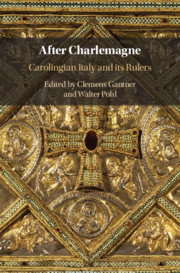Book contents
- After Charlemagne
- After Charlemagne
- Copyright page
- Contents
- Contributors
- Additional material
- 1 Italy after Charlemagne
- 2 A Brief Introduction to Italian Political History until 875
- Section I Was There a Carolingian Italy?
- Section II Organizing Italy
- Section III Carolingian Rulers
- 9 Staying Lombard While Becoming Carolingian?
- 10 Carolingian Fathers and Sons in Italy
- 11 A King in Training?
- Section IV Cities, Courts and Carolingians
- Bibliography
- Index
10 - Carolingian Fathers and Sons in Italy
Lothar I and Louis II’s Successful Partnership
from Section III - Carolingian Rulers
Published online by Cambridge University Press: 03 December 2020
- After Charlemagne
- After Charlemagne
- Copyright page
- Contents
- Contributors
- Additional material
- 1 Italy after Charlemagne
- 2 A Brief Introduction to Italian Political History until 875
- Section I Was There a Carolingian Italy?
- Section II Organizing Italy
- Section III Carolingian Rulers
- 9 Staying Lombard While Becoming Carolingian?
- 10 Carolingian Fathers and Sons in Italy
- 11 A King in Training?
- Section IV Cities, Courts and Carolingians
- Bibliography
- Index
Summary
Successive Carolingian rulers found managing the relationship with their adult sons challenging. The father-son relationship between Lothar I and his oldest son, Louis II, offers a valuable perspective on the forces at work in the relationships between senior and junior rulers more widely, as well as the specific challenges involved in ruling Italy from Francia. While our sources generally emphasize obedience to the father, successful father-son partnerships also had reciprocal elements, and involved effort on both sides. Lothar I and Louis II seem to have maintained a stable and productive relationship between 840 and Lothar’s death in 855. Public affirmation of the partnership between father and son, Lothar’s gradual delegation of power to Louis II, and the absence of key triggers for rebellion, such as a direct threat to Louis II’s position, help account for this success. A tight-knit lay and ecclesiastical elite that spanned both courts also helped stabilize the relationship. When positive factors assisting the father’s control were absent, and negative factors prompting rebellion on the part of the son were present, Carolingian father-son relationships could and did go awry, as in Louis the Pious’s case.
- Type
- Chapter
- Information
- After CharlemagneCarolingian Italy and its Rulers, pp. 148 - 163Publisher: Cambridge University PressPrint publication year: 2020



